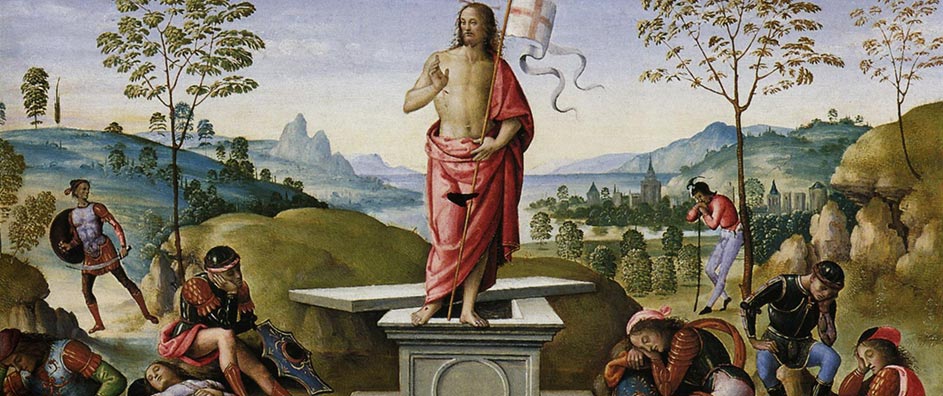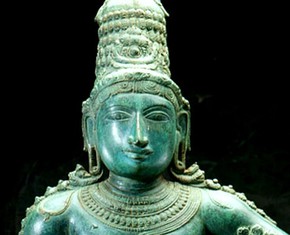The views expressed in our content reflect individual perspectives and do not represent the authoritative views of the Baha'i Faith.
On the third day he rose again in accordance with the Scriptures. – The Nicene Creed
If Christ has not been raised, your faith is futile. – 1 Corinthians 15:17.
Those of us who grew up in Christian cultures as children remember the magic and the mystery of Easter—the Easter eggs, the Easter bunny, the sunrise church services, and mostly the mysterious concept of Christ arisen from the dead after three days in his tomb.
 This miraculous occurrence—Christ’s resurrection after his crucifixion—filled me with wonder as a child. I accepted it just like children everywhere believe what they’re told, marveling at its wondrous improbability. But as I grew up and learned a little bit about science and reason, I began to seriously question this miracle. How could someone die, and then live again? It seemed impossible.
This miraculous occurrence—Christ’s resurrection after his crucifixion—filled me with wonder as a child. I accepted it just like children everywhere believe what they’re told, marveling at its wondrous improbability. But as I grew up and learned a little bit about science and reason, I began to seriously question this miracle. How could someone die, and then live again? It seemed impossible.
So I embarked, a curious and conflicted twelve-year-old, on an Easter project of my own. I went to the library and began to read. I asked my friend Mrs. Weston, the kind, friendly librarian in our small town, to show me where I could learn more about Easter. She did, and what I learned amazed me.
Easter, it turns out, started as a holiday celebrating the coming of spring, fertility and the dawn, all exemplified by Eostre, the great mother goddess of the Saxon people in northern England. Her name came from the archaic word for spring—eastre. Throughout the ancient world at the time, I learned, similar goddesses of spring and fecundity were known by other names: Aphrodite from Rome; Ashtoreth from ancient Israel; Astarte from ancient Greece; Hathor from Egypt; Ishtar from Assyria; Kali from India; Ostara, the Norse goddess of fertility; and Vestra from the Slavic regions.
So how, I asked Mrs. Weston, did that name become a Christian holy day? She showed me a translation of a book called German Mythology by Jacob Grimm—who I knew about because I had read the collected mythology and folk tales he and his brother had assembled. Here’s what Jacob Grimm had to say about Eostre:
Ostara, Eástre seems therefore to have been the divinity of the radiant dawn, of upspringing light, a spectacle that brings joy and blessing, whose meaning could be easily adapted by the resurrection-day of the Christian’s God. Bonfires were lighted at Easter and according to popular belief of long standing, the moment the sun rises on Easter Sunday morning, he gives three joyful leaps, he dances for joy… This Ostarâ, like the [Anglo-Saxon] Eástre, must in heathen religion have denoted a higher being, whose worship was so firmly rooted, that the Christian teachers tolerated the name, and applied it to one of their own grandest anniversaries. – Deutsche Mythologie, 1835.
I eventually found out that when the spread of Christianity westward from the holy land reached the Anglo-Saxon peoples, in order to make the Christian converts comfortable with their new religion, the church leaders simply co-opted the name, the symbols and the traditions of their indigenous celebration.
Learning all this caused me to reject the whole idea of Easter. Like a kid finding out about the reality of Santa Claus, I felt somehow tricked. When I researched a little more about the miracle of Christ’s resurrection, I began to suspect that the Church had simply adopted and embellished this tale, too, making Christ’s miraculous empty tomb an article of faith rather than something real.
It wasn’t until I became a Baha’i, later in my teenage years, that I began to understand Easter’s true meaning:
The resurrection of the Manifestation of God is not of the body. All that pertains to them—all Their states and conditions, all that They do, found, teach, interpret, illustrate, and instruct—is of a mystical and spiritual character and does not belong to the realm of materiality.
Such is the case of Christ’s coming from heaven… since it is established that Christ came from the spiritual heaven of the divine Kingdom, His disappearance into the earth for three days must also have a mystical rather than a literal meaning. In the same manner, His resurrection from the bosom of the earth is a mystical matter and expresses a spiritual rather than a material condition. And His ascension to heaven, likewise, is spiritual and not material in nature.
…After the martyrdom of Christ, the Apostles were perplexed and dismayed. The reality of Christ, which consists in His teachings, His bounties, His perfections, and His spiritual power, was hidden and concealed for two or three days after His martyrdom, and had no outward appearance or manifestation—indeed, it was as though it were entirely lost. For those who truly believed were few in number, and even those were perplexed and dismayed. The Cause of Christ was thus as a lifeless body. After three days the Apostles became firm and steadfast, arose to aid the Cause of Christ, resolved to promote the divine teachings and practise their Lord’s admonitions, and endeavoured to serve him. Then did the reality of Christ become resplendent, His grace shine forth, His religion find new life, and His teachings and admonitions become manifest and visible. In other words, the Cause of Christ, which was like unto a lifeless body, was quickened to life and surrounded by the grace of the Holy Spirit.
Such is the meaning of the resurrection of Christ, and this was a true resurrection. But as the clergy did not grasp the meaning of the Gospels and did not comprehend this mystery, it has been claimed that religion is opposed to science, for among other things the ascension of Christ in a physical body to the material heavens is contrary to the mathematical sciences. But when the truth of this matter is clarified and this symbol is explained, it is in no way contradicted by science but rather affirmed by both science and reason. – Abdu’l-Baha, Some Answered Questions, newly revised edition, pp. 117-119.
You May Also Like
Comments

















How is this resolved?
I found that 10 indicated a non-material appearance; 5 indicated both a material and a non-material appearance; one did not indicate either way, and only one suggested a material appearance by itself (Matt 28: 9-10, in which the two Marys take hold of Jesus' feet). Thus, the predominant Biblical evidence suggests it was a non-material appearance, although some Christian leaders prefer to ...emphasize the material references while ignoring the rest.
As to the empty tomb, since Baha'u'llah asserts that the Bible is true, but sometimes misinterpreted, I'm inclined to think we need to accept that it was empty on Sunday morning as stated. It was closed by its owner on Friday afternoon, and then sealed and guarded by the Romans starting at some point on Saturday. But what happened between Friday evening and the time the tomb was sealed on Saturday is anyone's guess. One can imagine several people or groups of people that may have had a variety of reasons for removing His body, but that is purely speculation (unless you are inclined to accept a theory such as "The Lost Tomb of Jesus" which suggests that His bones were eventually stored in the family's ossuary in a different part of the city.)
* https://en.wikipedia.org/wiki/Mary_Magdalene